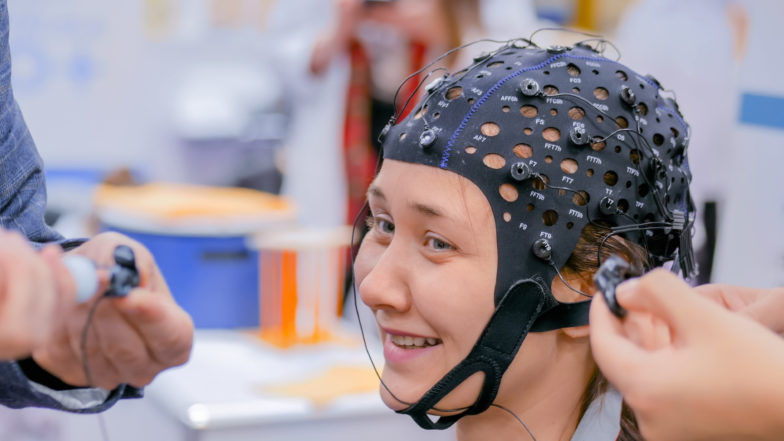A Case for Intelligent Design, Part 4 (of 4)
Scientists One Step Closer to Artificial Life and the Best Case for ID
Today much of the world is celebrating the 200th anniversary of Charles Darwin’s birth. Darwin’s theory of biological evolution has had a far-reaching impact on nearly every area of biology. It has also had profound philosophical and theological implications that fuel the creation/evolution controversy.
When Charles Darwin advanced his theory in On the Origin of Species in 1859, there was much about biology that he and his contemporaries didn’t understand. Darwin was aware of some of the gaps in his knowledge. But there remained much information that he didn’t realize was missing.
Over the last 150 years, scientific advance has yielded important understanding about life’s characteristics. Many of these discoveries, which provide the framework for modern biology, go beyond Darwin’s wildest dreams. Modern-day comprehension makes it possible for scientists to readily manipulate and modify life-forms in the laboratory.
One advance that would have probably surprised Darwin is the capability of scientists to not just manipulate life, but create artificial life in the laboratory. Very few scientists in Darwin’s time would have thought this possible. In fact most scientists even as recently as a couple of decades ago would have viewed this as an unreasonable goal.
As I have discussed for the last few weeks, Craig Venter, one of the pioneers in the field of genomics, recently founded a company called Synthetic Genomics (see here, here, and here for my articles). This group is striving to create artificial, nonnatural microbes for potential commercial and biomedical utility.
The newfound ability to make novel life-forms has been made possible, in part, by advances in the burgeoning new science of genomics These new insights, along with decades of research into biochemistry and molecular biology, have provided scientists with enough of an understanding of life’s most basic system–the cell–so that they can now potentially generate synthetic life-forms.
Nobody in Darwin’s day could realistically foresee such developments. In the mid 1800s, very little understanding existed of what distinguished life from nonlife. (In many respects, we still don’t have full understanding today.) For example, Darwin’s view of the cell comprised a different picture than modern scientists’. Darwin held to the protoplasmic theory–the idea that the cell consisted only of a wall surrounding a nucleus and a homogeneous, jelly-like protoplasm. Biologists and chemists of that time easily envisioned chemical routes on the early Earth capable of yielding the single ingredient believed to form the cell’s protoplasm.
By the end of the 19th century with the rise of biochemistry, however, the protoplasmic view of the cell was waning. Researchers recognized that the cell’s protoplasm was a complex, heterogeneous system. The cell’s marked complexity became apparent with the discovery of enzymes in the protoplasm capable of catalyzing a large collection of chemical reactions.
Over the last century, advances in biochemistry have continued to affirm the complexity of life at a molecular level. The most recent studies from genomics indicate that even the simplest bacterium requires close to 2,000 different proteins in the “protoplasm” for it to exist as a living entity. It’s not just that the cell’s chemical systems are complex: these systems display a remarkable degree of order and organization undergirded by an elegant, sophisticated logic. (For more details see my book The Cell’s Design.
Studies in genomics have also identified the essential genes required for an organism to exist as a life-form. Below a minimum number, about 380 genes, life doesn’t appear to be possible. This insight forms the basis for Venter’s plan to create artificial life in the lab.
The very real prospect of scientists creating life in the lab raises all sorts of concerns. Some conservative Christians think that the manufacture of novel life-forms by human hands eliminates the need for a divine Creator–thus, substantiating the evolutionary origin-of-life paradigm. Many Christians and skeptics alike believe that if scientists can create life in the lab, such a breakthrough will show that there is nothing special about life and that its origin could have easily taken place on the early Earth without God’s necessary involvement. Ironically, instead of supporting an evolutionary origin of life, Venter’s efforts demonstrate that life’s beginnings and transformation cannot happen apart from the work of an intelligent agent.
Minimum Requirements for Life
For example, Venter’s team must identify the minimal gene set required for life’s existence to re-engineer an artificial life-form from the top down. As they continue to hone in on life’s essential genes and biochemical systems, what’s most striking is the remarkable complexity of life even in its minimal form. And this basic complexity is the first clue that life requires a Creator.
Minimal life seems to be irreducibly complex. Based on Venter’s work, there appears to be a lower bound of several hundred genes, below which life cannot be pushed and still be recognized as “life.” As I argued in The Cell’s Design irreducible complexity is a hallmark characteristic of humanly constructed systems. By analogy, the irreducibly complex nature of life even in its bare essence implies that it, too, is the product of an intelligent agent.
In Darwin’s Black Box, biochemist Michael Behe makes the powerful case that irreducibly complex systems cannot emerge through an undirected, stepwise process. This obstacle makes it difficult to envision how natural evolutionary processes could have produced even life in its minimal state.
Hugh Ross and I reached the same conclusion in our book Origins of Life by considering the probability of the essential gene set coming into existence simultaneously. According to this analysis, it is super-astronomically improbable for the essential gene set to emerge simultaneously through natural means alone. If left up to an evolutionary process, not enough resources or time exist throughout the universe’s history to generate life even in its simplest form.
If not for the quest for artificial life, the immense complexity of life in its bare essential form would not be so rigorously demonstrated.
Using Existing Parts
As remarkable as it will be when Venter’s team succeeds in creating artificial life, it’s important not to view their accomplishment as more than it is. Headlines describing their work give the impression that these researchers are generating life solely from building-block materials. In reality, they are not building life from “scratch.” Instead, they are merely remodeling an existing life-form to generate a novel creature, known as Mycoplasma laboratorium.
Picture a microbe as similar to an automobile. In essence, Venter’s group is functioning like a curious auto mechanic disabling the parts of a car engine one at a time to indentify the core components of the engine that must be present for it to run at all. (This corresponds to the work Venter’s team has done to determine the minimum gene set.) Once the mechanic has identified the minimal parts list, he buys the essential engine parts from a “parts store” and assembles them into a minimal engine. (This step corresponds to the synthesis of the M. genitalium genome that I discussed in my three previous articles.) He then removes the motor from a perfectly working car and inserts the minimal engine into the vehicle to see if it still runs. (This step corresponds to the introduction of the synthetic genome into a cell that has had its genome removed.) If all these steps work, then the auto mechanic has not only confirmed that he has properly identified the essential engine parts, but has generated a novel automobile.
Need for Intelligent Intervention
The amount of intellectual effort expended by Venter’s team up to this point is astounding given the conceptually simple steps required to reengineer a life-form from the top down.
As I have discussed for the last few weeks, these researchers didn’t just rush into the lab and start throwing nucleotides into test tubes and running chemical and enzymatic reactions to achieve the total synthesis of the entire M. genitalium genome. Instead, they devised a synthesis strategy with painstaking effort.
Venter’s team carefully segmented the sequence of the entire M. genitalium genome into fragments (called cassettes) about 5,000-7,000 nucleotides (bp) in size. They carefully delineated the boundaries between cassettes so that these demarcations would reside between genes. They also designed the cassettes so that the sequences between two adjacent pieces of DNA overlapped by about 80 bp. This planning allowed them to piece together the M. genitalium genome in a manageable and orderly fashion.
They executed the synthesis and assembly in stages that included:
- using automated DNA synthesizers that utilize chemical and physical processes to synthesize and purify, respectively, about 10,000 short pieces of the genome approximately 50 bp in length;
- use of enzymes to biochemically combine the chemically made fragments into 101 larger fragments (about 5,000 to 7,000 bp each) that corresponded to the cassettes they mapped out at the drawing board stage;
- use of enzymes and the bacterium Escherichia coli to combine the 101 larger fragments into four fragments about 140,000 bp each;
- use of yeast to combine the four fragments into the entire genome.
Each stage of this process demanded exact planning and execution.
The technology to chemically synthesize oligonucleotides has been in place for several decades. Today, the chemical production of oligonucleotides is virtually an automated turnkey process. Still, it represents a remarkable technical accomplishment resulting from the dedicated efforts over the course of the last half century of some of the best scientists in the world (including Nobel laureates). Without these achievements, Venter’s team would have no hope of achieving their goal.
To assemble the chemically synthesized DNA pieces into increasingly larger DNA fragments, the Synthetic Genomics team needed to formulate a strategy that includes carefully selecting the appropriate enzymes based on their catalytic properties. It required designing the oligonucleotides–prior to the chemical synthesis step–so that they are compatible with the enzymes, and devising a reaction scheme that will yield the desired recombination product.
Choosing the yeast Saccharomyces cerevisiae to complete the assembly of the M. genitalium genome was also well-thought-out. This organism can take up extremely large pieces of foreign DNA when combined with a genome that is compatible with yeast. Instead of using enzymes in a test tube to complete the genome assembly, the scientists used the yeast’s biochemical machinery inside the cell to assemble the final pieces of the genome before they cloned it.
Given the effort that went into the synthesis of the total M. genitalium genome, it’s hard to envision how unintelligent, undirected processes could have generated life from a prebiotic soup. Though not their intention, Venter’s team unwittingly provided empirical evidence that life’s components, and consequently, life itself must stem from the work of an Intelligent Designer.
The goal of Darwin’s theory was to explain what was considered to be the mystery of mysteries in his time, the origin of species. Darwin proposed that the basis of species occurred through natural selection. Who would have thought that on the 150th anniversary of On the Origin of Species scientists would stand on the cusp of originating new species, not by undirected processes but by intelligently designed and expertly executed methods and procedures?
If Charles Darwin knew then what we know now would he have proposed his theory of biological evolution? It’s hard to say. But knowing what Darwin didn’t has been enough to cause a large number of scientists around the world, representing a range of scientific disciplines, to question the theory. And the attempts to create artificial life provide one more reason to view evolution with incredulity.
Related resources that may be of interest:
Creating Life in the Lab book by Fazale Rana (February, 2011)
“A Step to Artificial Life: Manmade DNA Powers Cell” Science News Flash podcast (5/21/10)
“The Celebrity of Artificial Life” web article
“Eating the Elephant Bite-by-Bite” web article
Part 1 | Part 2 | Part 3 | < a href=”/explore/publications/tnrtb/read/tnrtb/2009/02/11/a-case-for-intelligent-design-part-4-of-4
” target=”_blank”>Part 4





